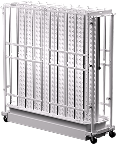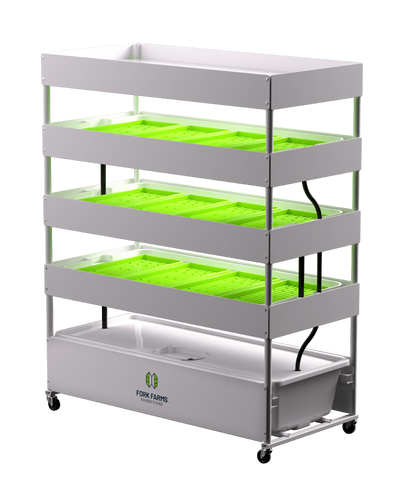Hydroponic Gardens: Overcoming America’s Food Deserts and Improving Access to Healthy Food
According to the CDC, a majority of Americans do not receive adequate nutrition. Often, the culprit is a high amount of “sodium, saturated fat, and sugar” in their diets, translating to an imbalance in the recommended daily nutrients. For many, the challenge goes beyond fostering healthy eating habits and extends to poor education around nutrition, a lack of access to nutritious options, and food insecurity. However, there is growing awareness of the importance of consistent, nutritious eating, with solutions, such as hydroponic gardens, designed to improve access to healthier food options.
Of course, the idea of having a personal garden isn’t new. Hydroponics is different and addresses various environmental and sustainability issues. To start, hydroponic gardens don’t use soil, and instead, plants grow in a nutrient-rich water solution. This solution gives plants all of the necessary elements they need to grow without overusing resources.
The additional advantages of these systems include:
- Growers have more control over the growing conditions, as light, temperature, humidity, and nutrient levels are optimized and managed.
- They are less prone to climate challenges such as drought, flooding, extreme heat, etc.
- Systems aren’t one-size-fits-all and some systems can be adjusted to fit any space
- Great for people looking to grow indoors, as the systems are mainly used within enclosed spaces.
- People can grow fresh and nutritious produce like lettuce and tomatoes from essentially anywhere in the world, regardless of the weather or season.
- Gardeners can grow their food year-round independent of the time of year.
- A better output of crops, as hydroponics provides a virtually pest-free environment
Solutions such as hydroponic gardens help break down barriers in traditional farming, providing a new way for people in urban and rural communities to gain access to healthy food. They can also be a game changer in areas like food deserts, where residents are continuously cut off from fresh produce.
What is a Food Desert?
The USDA uses census data to identify areas referred to as food deserts in “low-access and low-income” areas throughout the United States. People living in these urban, rural, and poorer areas often have to travel long distances to get to grocery stores, an expensive and inefficient way just to get food. Israel Gonzalez, 67, a resident of Syracuse, NY, for example, was interviewed for a piece with Syracuse University, revealing that he has to travel over a mile using just a wheelchair to get to a grocery store. Gonzalez isn’t alone, as an estimated 40.5 million Americans live in food deserts.
For people like Gonzalez, in a pinch, living in a food desert isn’t just about food scarcity. When the closest option for food is a store like 7/11, which only offers meals and snacks packed with sugar and sodium, many people don’t have better options for eating at their disposal. In the long term, people who live in food deserts can increase their chances of developing chronic illnesses and illnesses such as obesity, cancer, and diabetes.
Even if produce is available at stores a mile or so away, in food deserts, healthier options tend to be more expensive. For residents on budgets, the decision to buy cheaper options is an easy one. In more rural areas, affordability becomes even more of a challenge, as it can take anywhere from 45 minutes to an hour to get to any kind of store that sells fresh food at all. Overall, a lot of people living in food deserts may not even realize it, and only experience the day-to-day pain points of poor nutritional habits, expensive and inconvenient trips to get groceries and unbalanced diets.
The Benefits of Hydroponic Gardens In Improving Food Access
Hydroponic gardens are one solution individuals are turning to bridge the fresh food gap. In hydroponic systems, which include parts such as grow lights, nutrient solution, a growing tray, and an air pump, plant roots grow in water and nutrients. The nutrient film technique allows healthy plants to be grown using fewer pesticides and natural resources, making this growing medium a sustainable and innovative solution. The flexibility of vertical hydroponic gardens even makes it possible to place them everywhere from classrooms to apartments.
In addition to being a great solution for a range of spaces, hydroponic gardens can be cost-effective and environmentally friendly. With the right equipment, aspiring gardeners can grow more than 25+ lbs of fresh food every 28 days year-round. This also makes it a great addition to any community, making it possible for people to connect and collaborate over food. However, the implementation of a hydroponic garden alone isn’t enough to get started.
Hydroponic Gardens in the Community
A core part of improving access to healthy food is education. By implementing hydroponic gardens in community and government organizations, as well as libraries, schools, and nonprofits, communities can work together to improve the quality of education around growing food, maintaining gardens, cooking healthier recipes, and more. Education about healthier food can also be introduced at any age. Whether in the curriculum at the local elementary school or in classes and workshops at the local library, it is never too early or late to get started with gardening.
See how one school brought fresh food to a food desert in Michigan's Upper Peninsula
At Brownsville Collaborative Middle School in Brooklyn, for example, kids are exposed to gardening and wellness by working on their indoor hydroponic garden, which provides weekly produce to the school cafeteria. The Las Vegas-Clark County library district offers an open house for community members to learn the fundamentals of hydroponics. The Boys & Girls Club of Boston planted various hydroponic gardens around the city. These investments in education and awareness for the community go a long way, even inspiring residents on their own green initiatives.
Motivated by hydroponic systems in other countries, 13-year-old Steven Hoffen worked to bring vertical gardens into neighborhoods in need. Vital Root, a 100% employee-owned restaurant in Denver, grows its vegetables on-site, equal to about 2.5 acres of land. Bradwood Farm in Ashland, Ohio, has a commercial hydroponic greenhouse. In addition to traditional farming and raising cattle, the farm sells produce from its hydroponic garden at the local farmer’s market.
Getting Started with Hydroponic Gardens
When hydroponics are at the heart of communities, people can band together to create more sustainable and predictable food systems. Whether you’re a home gardener, librarian, educator, or chef, you’ll never run out of advantages to investing in a reliable hydroponic system. In addition to the ease of use and minimal space requirements, many systems come with customer support, helping to lower the learning curve for new growers.
With a system such as the Flex Farm, customers get ongoing support throughout the sales process, including pre-sale and onboarding. Even after setup, customers can join our active community of growers and farmers to get advice, share tips, troubleshoot, and get more information about the possibilities of hydroponic gardening. Ready to learn more? Explore our Flex Farm today!























